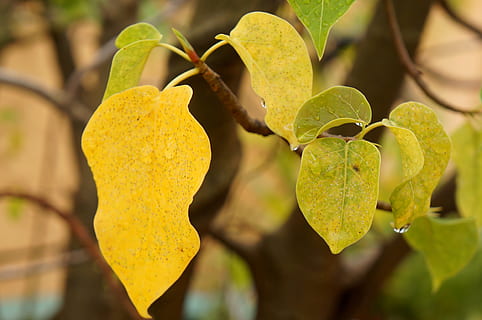Why do plants turn yellow? This is a question that any of us who are dedicated to the world of plants, whether farmers, gardeners or hobbyists of gardening and home gardens, have ever asked ourselves, and it is something common that usually occurs in some stage of our cultivation or in some season of the year.

There are several explanations for these color changes in the plant and they are generally due to two main reasons: the first has to do with the physiology of the plant: the phenological stage in which it is, its nutritional needs or some source of stress that causes a poor absorption of nutrients, and the second has to do with the phytosanitary nature of said plant, the attack of some fungi or bacteria. In this article we will address the yellowing (chlorosis) of a plant from a physiological point of view.
From the point of plant Physiology:
For a plant to grow and develop correctly (obeying its genetics) it requires approximately 16 to 17 nutritional elements (which can be in the so-called fertilizers), 3 of them, the plant will take through leaves and roots of natural way of the environment, Carbon, Hydrogen and Oxygen (organic). However, there are 13 other elements that are not always optimally found in soil and water; are the mineral elements.
One of the most important elements of this group (the minerals) is Nitrogen (an organic fraction of it can also be obtained). Nitrogen is abundant in the atmosphere; approximately 78% of the composition of the atmosphere is this element, however, it is not assimilable directly by the plant, the plant absorbs it through its roots with the help of certain bacteria known as Nitrogen Fixers (FN), another Nitrogen fraction is from Organic Matter.

When FN bacteria are scarce due to the management of the soil and the Organic Matter is depleted, the plants could express a symptom of Nitrogen deficiency, mainly in their leaves, and at this point we are going, Nitrogen is a key element (along with Magnesium), for the formation of chlorophyll, that green pigment in the plant that absorbs solar energy for photosynthesis; Without Nitrogen, the plant loses that intense green and becomes yellowish and weak, generally in all its leaves.
As I mentioned before, Magnesium is another fundamental element for the synthesis of chlorophyll, therefore, a clear symptom of deficiency of this element is a type of yellowing. But now another question arises, how to differentiate both types of yellowing, that of lack of Magnesium from that of Nitrogen? It is simpler than it seems, Nitrogen yellowing is uniform on the leaf, yellowing due to lack of Magnesium, it only occurs between the veins of the leaf, so that these veins are markedly greener than the rest of the leaves.
Other elements such as Iron and Zinc are also important for the synthesis of chlorophyll, they are very necessary elements in the early stages of cultivation and in the case of walnuts they are important until shortly before filling the fruit. These are not very mobile elements and the yellowing generated by the lack of them can be seen in the shoots and the middle part of the plants.

Finally, when the plant reaches its end (in the case of annual plants), it tends to release certain compounds (phytohormones) as a sign that its life cycle has come to an end, this compound is ethylene, a kind of hormone of the old age that signals to the cells and tissues that the end has come. Given this, we cannot do much since it obeys the genetics of the plant.

